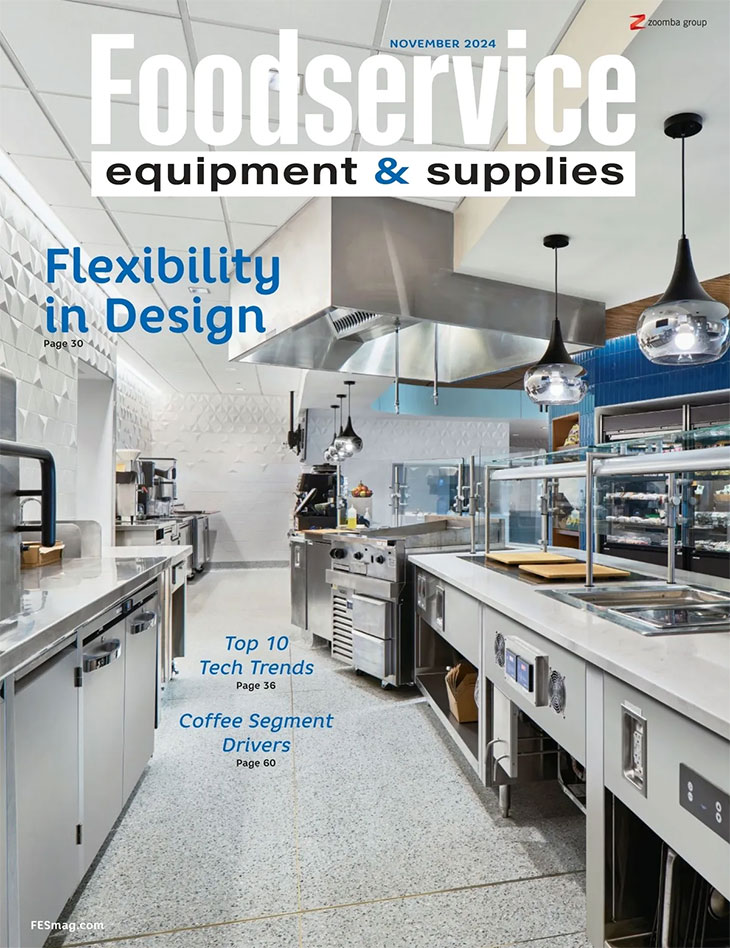In commercial foodservice, coffee stations have become a staple for speed and efficiency in serving traditional and specialty beverages.
With the ongoing popularity of specialty coffee, coffee stations have become all-encompassing with brewers, urns, espresso machines and grinders as staples.
Coffee brewers heat water between 195 degrees F and 202 degrees F and also have hot water faucets for producing oatmeal, hot chocolate and other items. A smaller brewer provides about 90 ounces of coffee in 3 minutes, while a larger-capacity unit takes longer but produces volumes of 1 to 2 gallons.
The three most common types of coffee brewers are pour-over, automatic and satellite. Pour-overs are best suited for low-volume operations and require staff to manually fill water reservoirs. These units dispense coffee into glass decanters, insulated servers or air pots.
Depending on the model, coffee brewer options may include intuitive color display panels that guide users through drink selection and preparation; a choice of preprogrammed specialty coffee beverages, such as lattes or macchiatos; integrated ceramic grinders; specialized frothing systems; and integrated rinsing, cleaning and descaling programs that reduce maintenance. Some coffee brewers can download flavor profiles from USB drives, while others can use pulsating heat capabilities to keep coffee at optimum serving temperatures. On some models, electronic air pot sensors provide easily visible volume and freshness alerts.
Coffee urns typically come in 1½-, 3- and 5-gallon sizes and feature stainless-steel construction. The shape depends on the type of urn. Variations include electric, soft heat and fuel-driven with gel-based fuels. Foam-insulated and vacuum-insulated urns keep coffee warm for one to six hours and require no hookups. Connected to a water line, urn brewers typically brew from 1½ to 10 gallons into holding liners. Urns with auto pumps, which produce up to 180 gallons of coffee, are used for high-volume applications. The most typical application is the twin 3-gallon and/or twin 6-gallon configuration.
Shuttle brewers are similar to urns but use applied heat. This equipment brews and dispenses up to 1½ gallons of coffee into heated shuttles for use in applications where turnover is usually 30 minutes from brew to depletion.
Thermal server brewers have a 400-cup capacity, and thermal servers hold up to 1½ gallons of coffee. These units are suitable for operations that regularly move large amounts of coffee to satellite holding stations and may serve multiple varietal or flavored coffees. Thermal servers hold coffee with no applied heat.
Espresso/cappuccino machines are typically categorized by the daily volume they produce. Capacities range from 10 to 20, 25 to 50, or 50 to 100 cups per day. These machines offer between one and four groups or brew heads, which determines how many espressos staff can brew at one time. Operators can choose from traditional manual, semiautomatic or fully automatic machines.
Traditional units require an experienced barista to manually grind the coffee beans, tamp the grounds, control the extraction time and add and steam milk. Semiautomatics, also called two-step units, automate espresso production, but the addition and steaming of milk still happens manually. Some machines incorporate temperature sensors in the steaming wand, which automatically stop the steaming process when milk reaches the appropriate temperature. Two-step machines also have whole bean hoppers on top, along with grinders incorporated into the machine. Super automatic machines, or one-steps, are fully automatic. With the push of a button, the machine grinds and tamps the beans, portions and dispenses coffee, and then steams and distributes milk. These units sometimes include a small refrigerator mounted to the side, which automatically inducts milk into the brewing process. All super automatics come with two hoppers and two grinders for regular and decaffeinated beverages. A third hopper for chocolate drinks is optional.
One espresso machine feature provides a heated tray to warm cups prior to filling, which protects the integrity of the beverage. Newer dual boilers provide temperature flexibility, allowing operators to serve two different espresso blends simultaneously while controlling how grounds are extracted. Operators can set programmable units to shut down and turn on automatically.
Commercial coffee grinders handle high-volume production. These include a hopper that holds the beans, a body that houses the motor, a loading bay with a doser lever that distributes various-sized portions, a tamper that compacts the coffee, a chamber above the base that holds the ground coffee, and a collar at the top of the chamber that adjusts the grind’s granularity.











